
* The Curtiss "C-46 Commando" was a twin-engine cargolifter used primarily by the US Army Air Forces (USAAF) in World War II, although it saw action with other services during the war, and in later conflicts. The C-46 remains largely forgotten, since it was overshadowed by the much more famous Douglas "C-47 Dakota" transport. This document provides a history and description of the Commando. A list of illustration credits is included at the end.
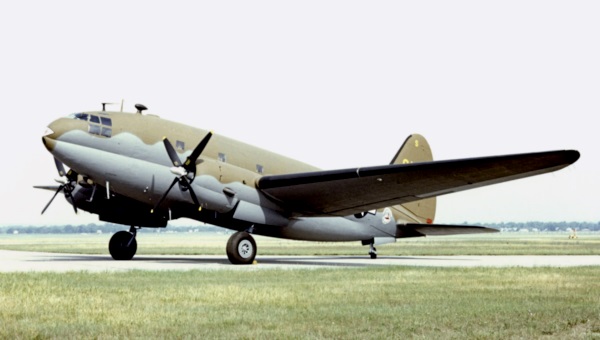
* The Curtiss Commando began life as a design for a 36-seat commercial airliner with a pressurized cabin, designated the "CW-20", with development initiated by Curtiss in 1936 under an engineering team led by chief designer George W. Page. The CW-20 was intended to provide a larger, more capable competitor to the Douglas DC-3, which was then entering service.
The CW-20 featured a roomy "double bubble" fuselage, with a cross-section in the form of two circle segments mated together, top and bottom. This configuration provided large internal volume and the structural strength to support pressurization. The junction between the small segment and the larger top segment was faired over to improve aerodynamics. The CW-20 also featured a low wing with twin radial engines, twin tailfins, and fully retractable tailwheel landing gear -- the single-wheel main gear retracting into the engine nacelles. The cockpit windscreen was flush with the fuselage contour, giving the aircraft a whale-like appearance.
The first "CW-20T" prototype was built at the Curtiss plant in Saint Louis, Missouri, and performed its initial flight on 26 March 1940, with Edmund T. "Eddie" Allen at the controls. Although Pratt & Whitney (P&W) R-2800 Double Wasp two-row air-cooled 18-cylinder radials were planned for the aircraft in production, the CW-20T was powered by two Wright R-2600 Cyclone engines with 1,194 kW (1,600 HP) each. Curtiss made a public announcement of the new airliner on 11 April 1940, giving it the name of "Substratosphere Transport", which was blessedly forgotten.
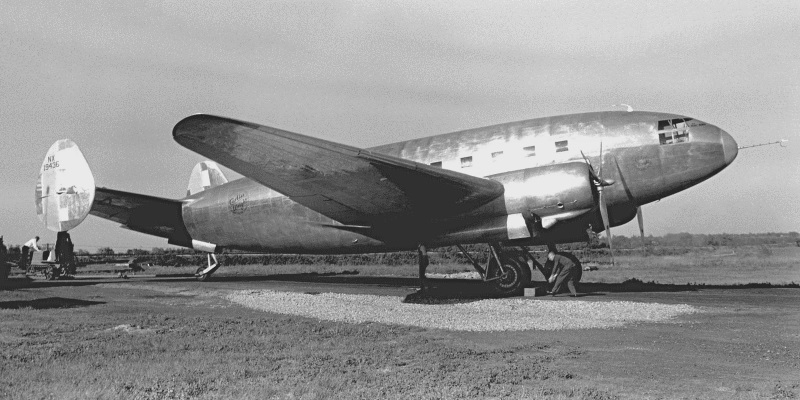
Flight tests quickly showed that the twin-fin tail left much to be desired, and it was replaced by a conventional tail arrangement with a single tailfin. The modified aircraft, now known as the "CW-20A", was demonstrated to airlines, and there were some interest in the type. However, in September 1940 the US Army Air Corps (USAAC), implementing an increasingly frantic program to prepare for war, ordered 200 modified "CW-20Bs" with the military designation of "C-46". Production began at the Curtiss plant in Buffalo, New York, with the first "Commando" delivered to the US Army Air Forces (which had superseded the Air Corps in the meantime) on 12 July 1942. Many more would follow. With a war on, Curtiss focused on military production, and commercial production was out of the question for the duration.
Incidentally, the CW-20A prototype was pressed into service by the USAAF as the "C-55" on 20 June 1941. It only served with the military for three months, then being sold to the British Overseas Airway Corporation (BOAC), which operated it as the "Saint Louis". It was scrapped in October 1943.
BACK_TO_TOP* The initial C-46 was an interim production type, rolled off the manufacturing line while Curtiss changed the design to fully meet USAAF specifications. The 26th aircraft delivered was the first full-specification "C-46A" or "CW-20B". Major changes in the C-46A relative to the CW-20A prototype included:
In addition to 40 troops, loads for the C-46A included 33 stretchers with attendants, or 4,550 kilograms (10,000 pounds) of cargo. The Commando was the largest twin-engine aircraft operated by the USAAF, and in fact its wingspan was 1.2 meters (4 feet) wider than that of a Boeing B-17 Flying Fortress. The Commando's fully loaded weight was almost twice as much as C-47's.
___________________________________________________________________
CURTISS C-46 COMMANDO:
___________________________________________________________________
wingspan:
32.92 meters (108 feet)
wing area:
126.16 sq_meters (1,358 sq_feet)
length:
23.27 meters (76 feet 4 inches)
height:
6.63 meters (21 feet 9 inches)
empty weight:
13,290 kilograms (29,300 pounds)
max loaded weight:
22,680 kilograms (50,000 pounds)
max speed at altitude:
378 KPH (235 MPH / 205 KT)
service ceiling:
6,700 meters (22,000 feet)
range:
2,900 kilometers (1,800 MI / 1,565 NMI)
___________________________________________________________________
The USAAF was enthusiastic about the Commando, and a total of 1,479 C-46s and C-46As were built by Curtiss in plants at Buffalo (1,039 "C-46A-CU" Commandos), Saint Louis (two "C-46A-CS" Commandos), and Louisville, Kentucky (438 "C-46A-CK" Commandos). They were flown by the US Army Air Transport Command, Air Service Command, and Troop Carrier Command. About 40 C-46As were passed on to the US Marine Corps with the designation "R5C-1", and some of these aircraft were later passed on to the US Naval Air Transport Command in turn.
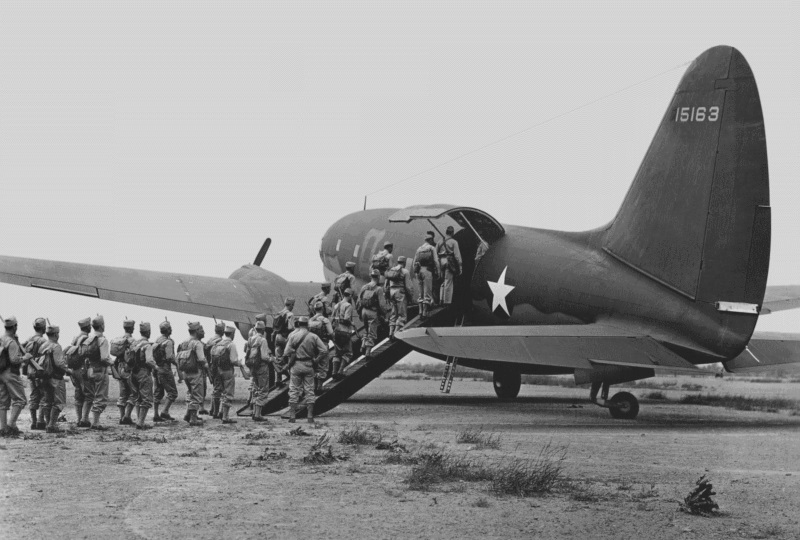
Demand for the type was so great that the USAAF placed an order for 500 C-46A Commandos with Higgins Industries, famed for construction of landing craft and torpedo boats, but only two "C-46A-HI" Commandos were actually built by Higgins, being delivered in October 1944.
* The Commando initially went into service on the South Atlantic ferry route, and also participated as a glider tug in the Rhine crossings in March 1945. However, due to its long range, it was primarily used in the Pacific and China-Burma-India (CBI) theaters, becoming the primary cargolifter for ferrying supplies from India to China over "the Hump", the Himalaya Mountains, after the Japanese shut down the Burma Road in 1943. Commandos of Colonel Edward H. Alexander's "India-China Wing" of the USAAF Air Transport Command flew from primitive airstrips in the Indian state of Assam, climbing with overload cargoes to clear ridges from 3.7 to 4.3 kilometers (12,000 to 14,000 feet) high, to land at Chunking and drop off their loads for USAAF General Claire Chennault's 14th Air Force and Nationalist Chinese forces.
The loss rate of the C-46 was high, and the type had a mixed reputation with aircrews. Partly the problem was the fact that the environment was very harsh, operating conditions were difficult, and Japanese fighters were an occasional threat. During one attack, Captain Wally A. Gayda shoved a Browning Automatic Rifle out one of the forward cabin windows and shot down the attacker. However, stories still circulate that the C-46 also suffered from a large number of engineering and manufacturing faults, in particular a leaky hydraulic system. Crews were said to take a barrel of hydraulic fluid along on flights to make sure that the hydraulic systems were topped off. There was also apparently a fuel leak problem that took a long time to work out, aircraft being lost in midair explosions at a steady rate until it was.
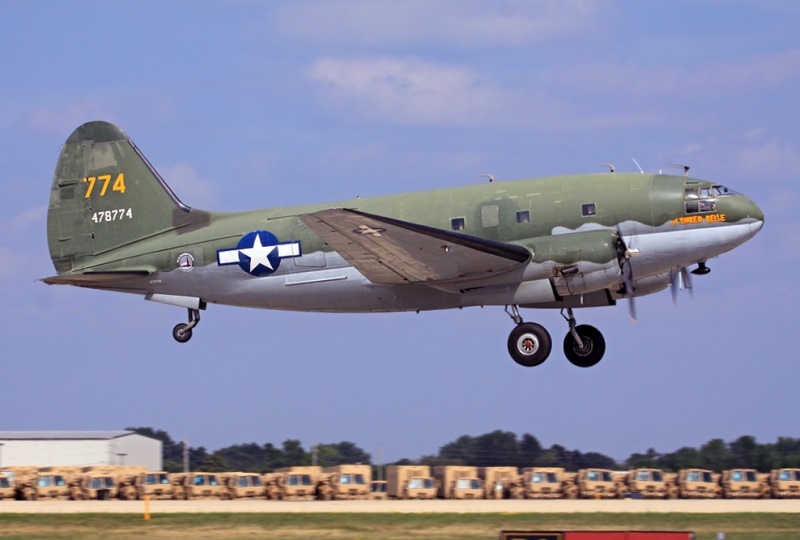
It doesn't appear that the C-46 was an inherently bad aircraft, it was just rushed into service without the level of qualification that it would have been run through in peacetime, and it took a lot of work to get the bugs fixed. The aircraft's detractors called it the "Curtiss Calamity" and the "Leaky Tiki" -- though it was also more affectionately named "Dumbo", after the flying baby elephant in Walt Disney's 1941 animated movie.
BACK_TO_TOP* There were a number of Commando variants, but only two were produced in numbers besides the C-46A:
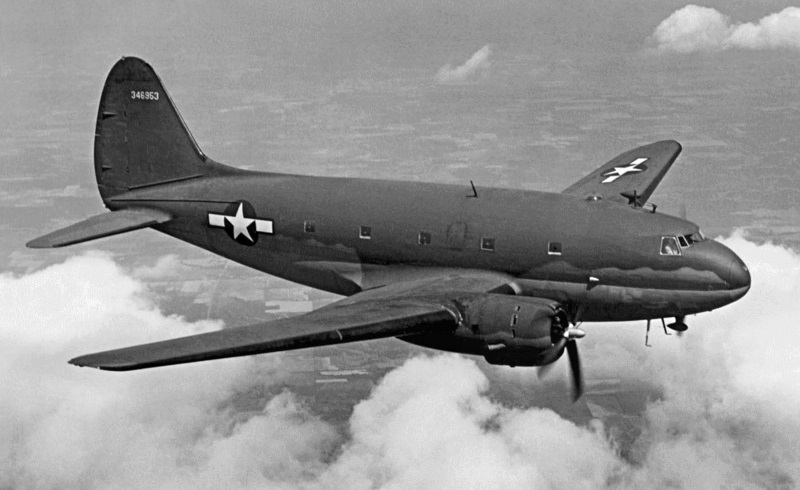
Minor variants included:
Pictures of Commandos show some of them fitted with a radio-compass loop antenna behind the cockpit, which would be a valuable piece of gear for Asian operations over long distances and in monsoon weather, but it is unclear if this was associated with a particular variant, with specific factory blocks, or was a field fit. Total Commando production came to 3,140 aircraft.
BACK_TO_TOP* Although large numbers of surplus Commandos were sold to civilian operators in the rapid military wind-down after World War II, the C-46 remained in US military service in good quantities well into the 1950s. Some were adapted as "TC-46D" trainers for the US Air Force (USAF), which the USAAF became in 1947.
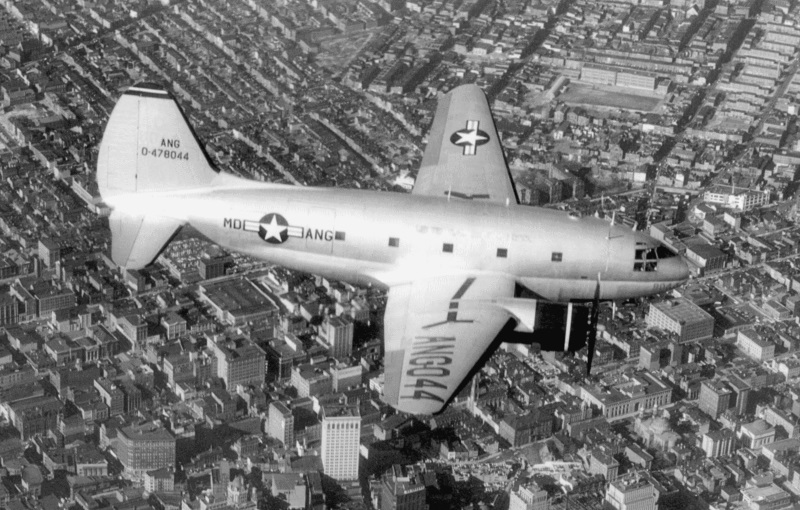
The outbreak of the Korean War caught the US unprepared and scrambling for resources. C-46s were pulled out of mothballs or even bought back from commercial operators, and put into round-the-clock use with the USAF Combat Cargo Command hauling supplies from Japan to Korea, as well as participating in paratroop drops. Commandos were still in US military service in the 1960s, and were used by the USAF 1st Air Commando Group for jungle supply drops and deliveries during the early part of the Vietnam War. The last Commandos were retired from USAF service in 1968.
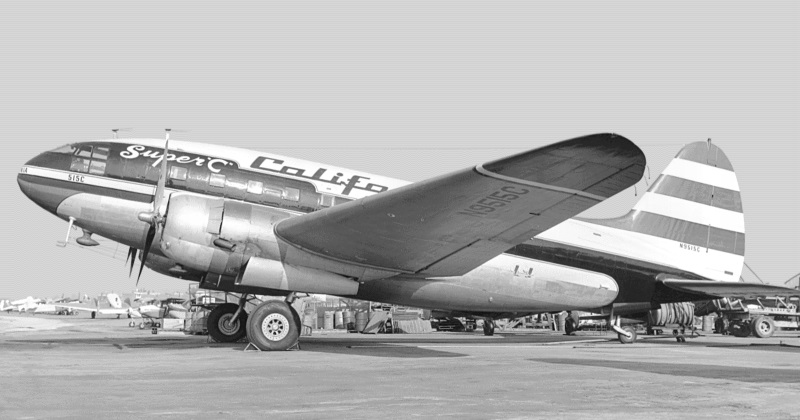
Civilian Commandos were put to plenty of good use, generally as air freighters, though some were converted to an airliner configuration with proper passenger accommodations. Even as late as 1980, 300 or more Commandos were still operating. Only a handful are still flying now. In the United States, two C-46Fs have been obtained by the Commemorative Air Force (CAF) and make appearances at airshows. One is painted silver with USAAF markings and is named "China Doll", though the CAF earlier flew it in Nationalist Chinese markings as "Humpty Dumpty". The other is painted camouflage green on top and light blue on the bottom; it is named "Tinker Bell".
BACK_TO_TOP* While the USAAF was awarding contracts to Curtiss to bring the C-46 Commando into operation, the service was hedging bets by ordering a second transport from Curtiss, the "CW-27" or "C-76 Caravan". The Caravan was to be made as much as possible of wood in case supplies of light alloys dried up.
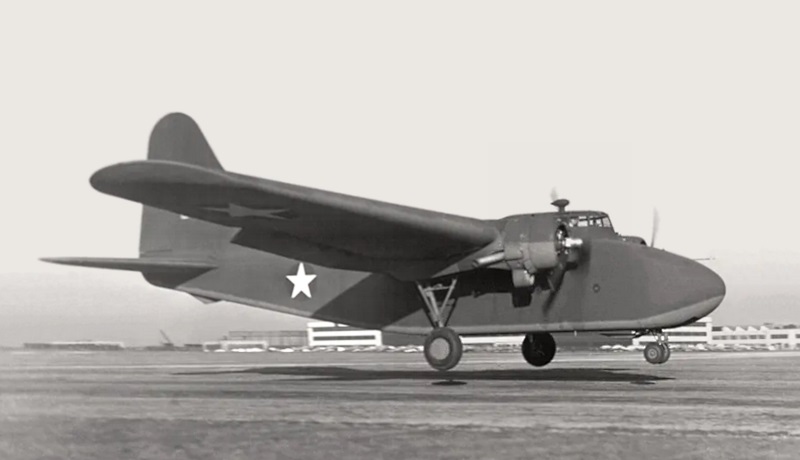
The USAAF placed an order for 11 "YC-76" pre-production aircraft in 1941, with the first performing its initial flight on 1 January 1943. The Caravan an inelegant-looking aircraft, resembling a large cargo glider. It was smaller than the Commando and of different configuration, with a shoulder-mounted wing, a stepped-up cockpit, and retractable tricycle landing gear. It was powered by twin P&W R-1830-92 Twin Wasp radials providing 895 kW (1,200 HP) each, and could carry 23 people, including the crew.
___________________________________________________________________
CURTISS C-76 CARAVAN:
___________________________________________________________________
wingspan:
32.97 meters (108 feet 2 inches)
wing area:
144.92 sq_meters (1,560 sq_feet)
length:
20.83 meters (68 feet 4 inches)
height:
8.31 meters (27 feet 3 inches)
empty weight:
8,300 kilograms (18,300 pounds)
loaded weight:
12,700 kilograms (28,000 pounds)
max speed at altitude:
310 KPH (192 MPH / 170 KT)
service ceiling:
6,900 meters (22,600 feet)
range:
1,210 kilometers (750 MI / 650 NMI)
___________________________________________________________________
The evaluation was successful, and Curtiss went on to produce five "C-76" initial production aircraft, plus nine "YC-76A" modified service evaluation aircraft. These were delivered in 1943, but by that time there was no reason to think the Caravan would be needed, and large production orders with both Curtiss and Higgins Industries were canceled.
BACK_TO_TOP* The C-46 remains a somewhat obscure aircraft, and information on it is both scarce and contradictory. Sources are particularly divided on its reputation, with many citing its lack of reliability. That wouldn't be too surprising given that Curtiss products were not exactly at the top of the class of American aircraft used in World War II. However, the long service history seems to hint that the aircraft was regarded as both capable and satisfactory, at least after Curtiss hammered the worst bugs out. One pilot who flew it during the Korean War, Lieutenant Spencer Grant, praised its reliability and capability highly, concluding: "In my opinion, the C-47 always got top billing, but the C-46 was twice the aircraft."

* Sources include:
Various small items were picked up on the web and in magazines as well, but individually amounted to a sentence or two and haven't been listed.
* Illustration credits:
* Revision history:
v1.0 / 01 aug 01 v1.0.1 / 01 jan 02 / Review & polish. v1.0.2 / 01 jan 04 / Review & polish. v1.0.3 / 01 jan 06 / Review & polish. v1.0.4 / 01 dec 07 / Review & polish. v1.0.5 / 01 nov 09 / Review & polish. v1.0.6 / 01 oct 11 / Review & polish. v1.0.7 / 01 sep 13 / Review & polish. v1.0.8 / 01 aug 15 / Review & polish. v1.0.9 / 01 jul 17 / Review & polish. v1.1.0 / 01 jun 19 / Review & polish. v1.2.0 / 01 jun 21 / Illustrations update. v1.2.1 / 01 may 23 / Review & polish. v1.2.2 / 01 may 25 / Review & polish.BACK_TO_TOP
